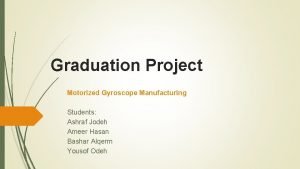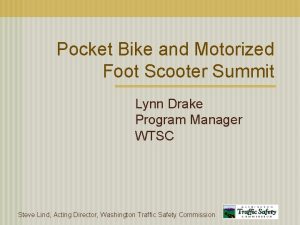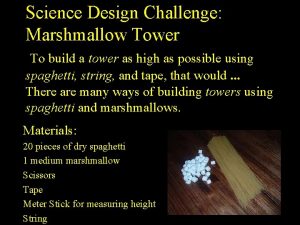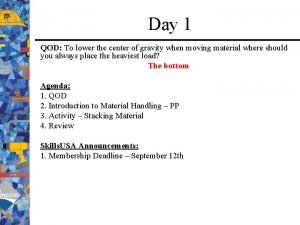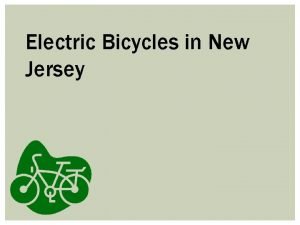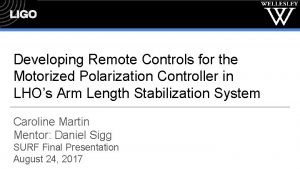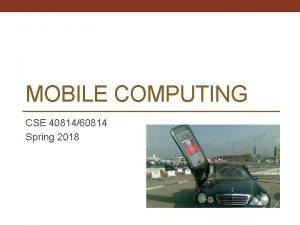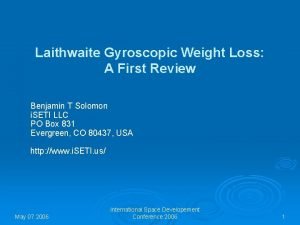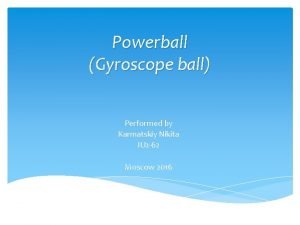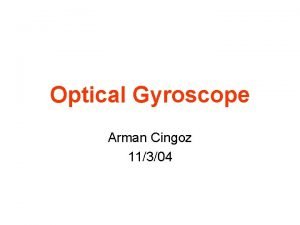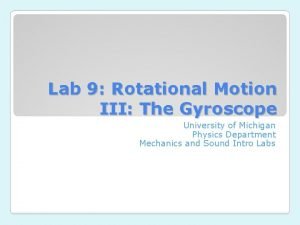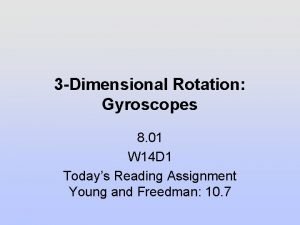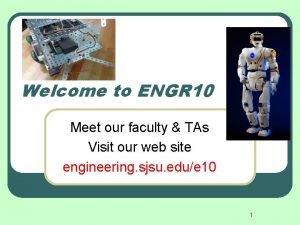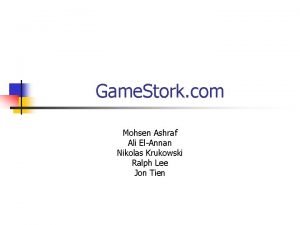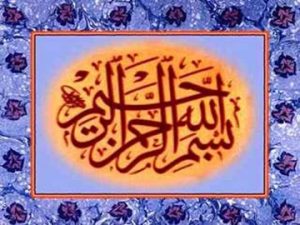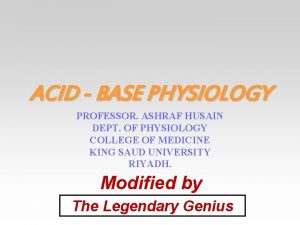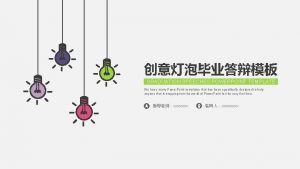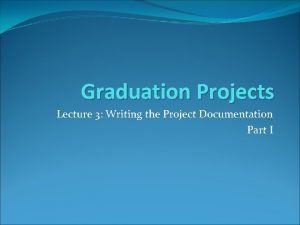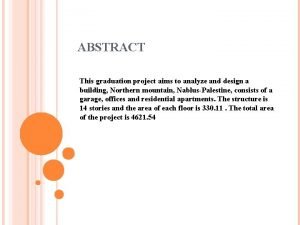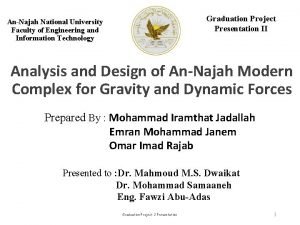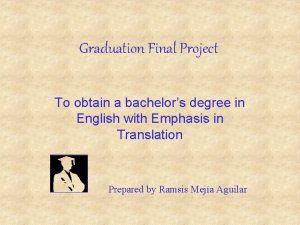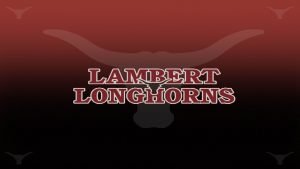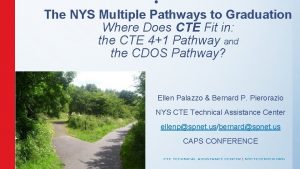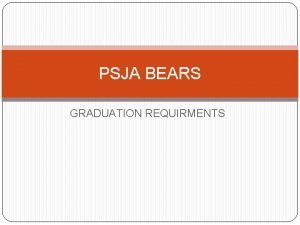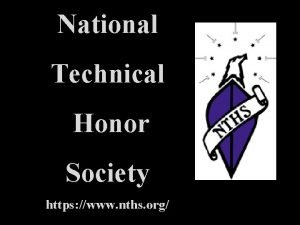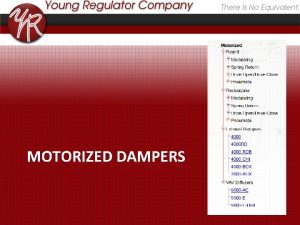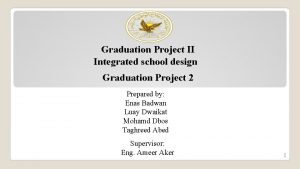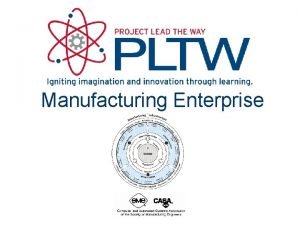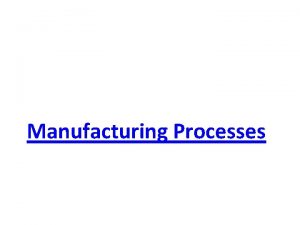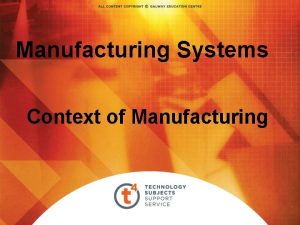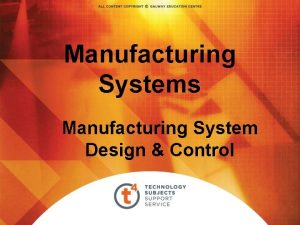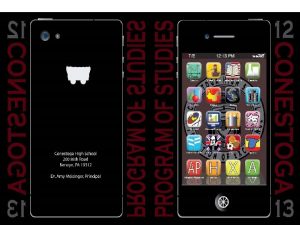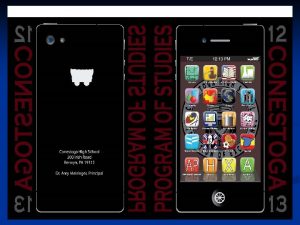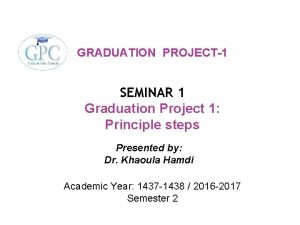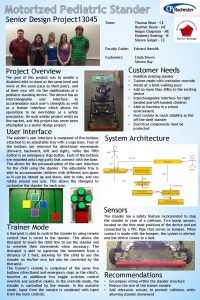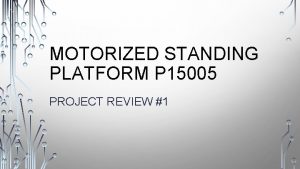Graduation Project Motorized Gyroscope Manufacturing Students Ashraf Jodeh



















































- Slides: 51

Graduation Project Motorized Gyroscope Manufacturing Students: Ashraf Jodeh Ameer Hasan Bashar Alqerm Yousof Odeh

Contents ü Abstract ü What is Gyroscope ? ü History ü Problem Definition ü Gyroscopic Principles ü Manufacturing (Mechanical and Electrical parts) ü Experiment

Abstract The idea of this project is to design and manufacture a gyroscope which is driven by an electric motor to make it spin indefinitely.

What is the Gyroscope? The gyroscope is a device for measuring or maintaining orientation, based on the principles of angular momentum.

History of Gyros. Basically, a gyroscope is a top, a self-balancing spinning toy, put to instrumental use.

Cont. • John Serson who is the first one use a top as an instrument when he invented the "Whirling speculum" (or Serson's Speculum) in 1743. “Artificial Horizon” • In 1817, German Johann Bohnenberger used the instrument as an actual gyroscope. • In 1852, Leon Foucault used the gyroscope in an experiment to see the Earth's rotation.

Cont. • In 1860, electric motors used to make the gyroscope spin indefinitely. . • In 1909, Elmer A. Sperry built the first automatic pilot for aircraft using gyroscopes.

Cont. • 20 th century, gyroscope used in black box navigational systems and for inertial guidance systems for ballistic missiles. • Today the MEMS (Micro Electro-Mechanical System) gyroscopes have enabled exciting applications in portable devices.

Problem definition Gyroscope is very important tool used for various controls in high technology vehicles and devices, and takes a good place in research and development. Thus the study of gyroscope behavior is so important for engineering students.

Gyroscopic Principles The gyroscope exhibits two predominant characteristics: 1. Rigidity in Space 2. Precession

1. Rigidity in Space The spinning rotor inside a gyro instrument maintains a constant attitude in space as long as no outside forces change its motion. This stability increases if the rotor has great mass and speed.

2. Precession Another characteristic of gyros is precession, which is the tilting or turning of the gyro spinning axis as a result of applied forces.

Electrical and Mechanical parts

The Universal Motor

General Description: Universal or series motors are those having brushes, a wound rotor, and a wound stator. They are compatible with both AC and DC power. They are also distinguished by their noisiness. These motors produce so much noise because the brushes rub on the slotted armature.

Uses Manufacturers use universal motors because they are smaller and much lighter than induction motors. An example of this type is that found in a portable drill or a Dremel tool. Basically the DC motor characteristics that can be run on AC.

Comparison to Induction Motors: A 3/4 Hp induction motor. . . runs at 1075 - 3450 RPM, is about 6" long x 6" diameter and weighs about 19 pounds. If we compare this with a universal motor with 3/4 horsepower output, we see a speed increase of about 15, 000 RPM, a size reduction to about 6" long x 3" diameter {1/4 of the volume} and a weight reduction of greater than 85%.

Advantage 1. The weight difference is huge: Universal motors are much lighter than induction motors 2. Torque goes clear down to stall torque (DC motors will stall at a high RPM) 3. Lower cost 4. Variable speeds

Disadvantage: 1. Non reversible (one direction) 2. Noisy 3. universal motors are usually relatively inefficient- around 30% for smaller motors 4. and up to 70 -75% for larger ones. 5. the commentator has brushes that wear, so they are much less often used for 6. equipment that is in continuous use

Tachometers

Tachometer, What’s That? Tachometer is used for measuring rotational speed Can be used to measure speed of a rotating shaft Can also be used to measure flow of liquid by attaching a wheel with inclined vanes

What Are the Different Types of Tachometers? Tachometers can be classified on the basis of data acquisition – contact or non contact types They can also be classified on the basis of the measurement technique – time based or frequency based technique of measurement They can also be classified as analog or digital type

Typical Specifications of a Non Contact Type Tachometer Display 5 digits large LCD Range: 2. 5 - 99, 999 RPM Distance: 50 to 1, 000 mm; 12 to 40 inches. Resolution: 0. 1 RPM<1000 RPM (2. 5 to 9, 999 RPM) 1. 0 RPM >1000 RPM Measurement angle: at less than 120 degrees. Range selection: Auto Laser Output Power: <1 m. W class II Sampling Time: 1. 0 seconds (over 60 RPM) Memory: Last value, Max Value, Min. Value Time base: Quartz crystal Circuit: Exclusive one-chip LSI circuit Battery: 4 X 1. 5 V AA Weight: 300 g/0. 65 lb Size: 190 X 72 X 37 mm

Block Diagram of a Digital Tachometer Display Optical / Magnetic Sensor Signal Conditioning Microcontroller Memory External Port (to controller)

Microcontroller Not essential, but is generally the norm to have a microcontroller Compute the speed Can store the readings Can output values to a display unit Give out warning signal when speed reduces / increases beyond set margins Transfer data to external controller We used the aurdino as a microcontroller

What is Arduino? A programmable micro controller for prototyping electromechanical devices You can connect Digital and Analog electronic signals: Sensors (Gyroscopes, GPS Locators, accelerometers) Actuators (LEDS or electrical motors)

Arduino Components

Bearings The typical structure for bearings involves : - inner race - outer race - Inner ring - Outer ring - separator or ( cage ) - Balls or rollers

As we see in the figure :

Types of rolling element bearings 1. ball bearing ( spherical rolling elements ) single row double row Angular cotact angular contact single row double row deep-groove radial

single row deep-groove Double row deep-groove Externally self-aligning Internally self-aligning grooved race thrust

2. roller bearings (cylindrical rolling elements ) single row straight roller bearing double row straight single row tapered roller bearing self-aligning roller bearing double row tapered roller bearing self–aligning single row spherical roller bearing double row spherical needle roller tapered roller thrust

Bearing materials the responsibility for achieving the design objectives ( selection the best material best geometry ) lies with the specialized designer working in the bearing industry. The material of ball & races : • . 1 1. high carbon chrome steel : hardened and tempered for optimum strength and toughness. 2. stainless-stee : used when corrosion resistance is needed or elevated temp. 3. Cobalt : for higher temp applications. * the separator material include : • phenolic , bronze , phosphor bronze , or alloy steels such as AISI 4130. •

Procedure for selecting an appropriate bearing for our project : 1. shaft of the motor and the disc. - diameter = 10 mm. - Fᵣ =20 N. - shaft speed = 4500 rpm. - design life specification is 10 years of operation , 50 days/year, 20 hr/day. - design reliability specification is R =90 percent. - the shaft is uniform load. Ld = 10 yr * (50 days/yr) *(20 hr/day) (60 min/hr) 4500 rev/min = 27 X 10^8 revolutions. From table of reliability Kr = 1 From table of impact factor IF = 1. 1

Pe = Xd *Fr + Yd*Fa Xd 1= 1 Yd 1= 0 Xd 2 =0. 55 Yd 2 = 1. 45 Pe 1 =(1)(20)= 20 N Pe 2 =(0. 55)(20) = 11 N Pe 1>Pe 2 Select the larger Pe 1= 20 N [ Cd(90) ]req =( 27 x 10^8 /(10^6) )⅓(1. 1)(20) = 306. 3 N Select bearing type (6000)

Pse =Xs*Fsr + Ys * Fsa Xs 1= 1 Ys 1 = 0 Xs 2= 0. 6 Ys 2 = 0. 5 (Pse)1 =(1)(20) =20 N (Pse)2 =(0. 6)(20) =12 N (Pse)1>(Pse)2 Select the large r( Pse)1 = Cs Select bearing number (6000) Type of bearing for the shaft is ( 6000)

2. standing shaft - diameter = 40 mm - Fa =200 N. - shaft speed = 4500 rpm - R =90 percent Kr = 1 - the shaft is uniform load IF = 1 Ld = 27 x 10^8 rev. [ Cd(90) ]req = 4442. 0005 n Select bearing type (6008) ( Pse)2 = Cs = 100 n Select bearing number (6008) Type of bearing for the shaft is ( 6008)

3. shaft that will connect the body of disk with body standing. - diameter = 12 mm - Fᵣ =15 N. - shaft speed = 4500 rpm - R =90 percent Kr = 1 - the shaft is uniform load IF = 1 - Ld = 27 x 10^8 rev. [ Cd(90) ]req = 229. 75 N Select bearing type (6002) ( Pse)1 = Cs = 15 n Select bearing number (6002) Type of bearing for the shaft is ( 6002)

Specifications Mass of rotating disk = 1. 2 Kg. The radius of the rotating disk = 0. 1 m. The distance from the disk to the weight = 0. 2 m. Motor speed ranged (1 -1000)r. p. m.

Material Really, I do not know the type of material which being used. But I will try to predict it from machining processes.

Material Structure machining : At low cutting speed, I obtained a continuous chips with built-up edge. and The formation of these chips start cycle then break off.

Material That mean I have a low carbon steel (ductile material). as shown in figure (1). Fig. (1): Continuous Chips

Material Disk machining: At low cutting speed, I obtained a discontinuous chips and high tool chips friction.

Material That mean I have high carbon steel (brittle material). as shown in figure (2). Fig. (2): Discontinuous Chips

Connecting Using some types of bolts, pins and Shielded Metal Arc Welding and Argon Arc Welding to connect parts of the structure.

Connecting Why argon: Using Argon Arc Welding to connect the boxes of bearings with the structure. It is more suitable welding for thin parts because it gives a narrow bead and no splatter.

Conclusion As we know we built these apparatus to verify the relation between spinning velocity, applied torque with precessional velocity.

Conclusion Precessional velocity ωp (r. p. m) Precessional velocity is directly proportional with applied torque as shown in figure(3). 10 8 6 4 2 0 0 0, 1 0, 2 Applied torque T (N. m) 0, 3 Fig. (3): Torque vs. Precessional velocity

Conclusion Precessional velocity ωp(r. p. m) precessional velocity is inversely proportional with spinning velocity as shown in figure(4). 2, 5 2 1, 5 1 0, 5 0 0 250 500 750 Spin velocity ω (r. p. m) 1000 Fig. (4): Precessional velocity vs. Spin velocity

Sources of error The error of apparatus is 10. 2% induced by friction of bearing and huge vibration caused by universal motor. Therefor, We used dampers and coupling joint to reduce these vibrations and improving accuracy.

Thank You.
 Motorized gyroscope
Motorized gyroscope Motorized foot scooter
Motorized foot scooter Spaghetti and marshmallow bridge
Spaghetti and marshmallow bridge Motorized material handling equipment
Motorized material handling equipment Are motorized bicycles legal in new jersey
Are motorized bicycles legal in new jersey Motorized polarization controller
Motorized polarization controller Mems gyroscope
Mems gyroscope Eric laithwaite gyroscope
Eric laithwaite gyroscope Powerball physics
Powerball physics Sagnac effect gyroscope
Sagnac effect gyroscope Gyroscope
Gyroscope Gyroscope
Gyroscope Gyroscope
Gyroscope Intensity of distribution
Intensity of distribution Peggy boylan-ashraf sjsu
Peggy boylan-ashraf sjsu Dr tariq ashraf
Dr tariq ashraf Ali el-annan
Ali el-annan Ashraf husain
Ashraf husain Ashraf husain
Ashraf husain Gastrointestinal disease
Gastrointestinal disease Ashraf marwan
Ashraf marwan Manufacturing cost vs non manufacturing cost
Manufacturing cost vs non manufacturing cost Job costing and process costing
Job costing and process costing Non controllable cost
Non controllable cost Manufacturing cost vs non manufacturing cost
Manufacturing cost vs non manufacturing cost Additively
Additively High school graduation powerpoint template
High school graduation powerpoint template Graduation project report example
Graduation project report example Abstract for graduation project
Abstract for graduation project Introduction for graduation project
Introduction for graduation project Graduation project documentation
Graduation project documentation Documentation for graduation project computer science
Documentation for graduation project computer science Abstract for graduation project
Abstract for graduation project Final project bachelor degree
Final project bachelor degree Rizal and his party went to pagsanjan for what reason?
Rizal and his party went to pagsanjan for what reason? Project based learning for students with special needs
Project based learning for students with special needs Windermere high school curriculum guide
Windermere high school curriculum guide Best buddies graduation cords
Best buddies graduation cords Best buddies graduation cords
Best buddies graduation cords Basha high school prom 2022
Basha high school prom 2022 Lambert high school counseling
Lambert high school counseling Hanahan middle school dress code
Hanahan middle school dress code Wasilla high school graduation 2022
Wasilla high school graduation 2022 Nycte
Nycte Agenda for graduation meeting
Agenda for graduation meeting Graduation is just the beginning
Graduation is just the beginning Lths graduation requirements
Lths graduation requirements Psja bears graduation 2022
Psja bears graduation 2022 Ponchatoula high school graduation
Ponchatoula high school graduation Stefanie klose
Stefanie klose Ncpa student chapter logo
Ncpa student chapter logo Nths cord
Nths cord
